Fire in the Hole! How To Conduct a Personal Fire Safety Survey
Fire in the Hole! How To Conduct a Personal Fire Safety Survey
It happens. You’re more likely to die in a fire here in the United States, than any other industrialized nation. The Station Night Club in Rhode Island, 100 people killed. The Ghost Ship fire in San Francisco, 37 people killed. Between 2009 and 2013, 12 people were killed and additional 299 were injured in mercantile store fires. However, 1,533 people died in residential home fires between January 1, 2017 and September 26, 2017. It’s your responsibility to make sure you don’t put yourself in a location or situation that increases your risk.
Let’s start with your home. Hopefully you heed your kid’s warnings when they come home from school after fire safety week. Do your smoke detectors work? Seriously, when was the last time you checked them? Your best bet and the easiest way to remember when to change the batteries, is when you change your clocks for Daylight Saving Time. Once the new batteries are in, press and hold the button make sure it goes off appropriately. Additionally, take the hose of your vacuum and keep that thing clean.
Tips for the Home
Fire extinguishers are dirt cheap and unbelievably effective. Like everything else in our life, they need maintenance to ensure they stay reliable. First and foremost, make sure the extinguisher is accessible; not under the sink, behind stacks of stuff you’ll have to clear out in order to reach. Check the gauge and make sure the extinguisher still has pressure.
Flip the extinguisher upside-down to give it a couple bumps with your fist and a moderate shake. You should do this at the same time you’re doing your smoke detector maintenance. If it’s no good or you don’t remember when you bought it, replace it and use the old one to practice. I would highly recommend you do your practice outside, as it tends to get a little messy.
Next up is your escape plan. Start off by sleeping with your bedroom door shut, as interior doors offer a limited amount of fire protection. If the alarm goes off, stay low, get out and call 9-1-1. In that order. Use the back of your hand to check a door for heat before you open it.
If you can’t make it out through your primary exit, go out a window. Are you on the second floor? Climb out the window, hang on to the window sill, dangle your feet, then drop to the ground. After you’re out, find and account for all family members.
That’s the easy part; making sure your stuff is in order and reliable. The tricky part is when you need to rely on people you don’t know to do their part and keep their buildings safe for public use.
Tips for Public Buildings

There are a couple different factors at play here, ignorance being a large one. People are sometimes unaware of the safety systems in their own building. Maybe they rely on others, perhaps an employee, to make sure their system is in order and that employee doesn’t realize how important it is to check and make sure the battery back-ups in the emergency lights are working.
Financial burden can be another factor, as fire and life safety systems require constant upkeep and can get expensive. However, this is just part of running a business. It’s not just you and your family at risk, it’s the public as a whole. Security is also a huge issue. For instance, some businesses will have an exit chained shut to keep people from helping their friends sneak in or to protect VIP’s, performers, etc. from the public. Last but not least there’s criminal intent; intentionally modifying or tampering with safety systems in order to do harm.
Here’s what you can do to lessen the risk factors. First of all, know the building. The more you frequent a place, (like your local grocery store) the better you should know it. The next time you run to the store, perform a Personal Safety Survey.
As soon as you walk in, look for secondary exits. In a panic situation, most people are going right back out the exit they came in. Why? It’s familiar and they’re certain they know where it is. Most places will have a secondary exit and larger places should have a tertiary exit and even more, depending on their size.
While you’re getting to know your building, really get to know it. As you walk in, do vehicles litter the fire lanes? One poorly placed car can really hinder the Fire Department in their duties. How do the entrances look in general? Are displays hanging over into the door way? Do they appear to be in good working order? Look up, is the exit light lit? Is there a tiny little red light on the bottom of it? Does the emergency light look to be in good working order?
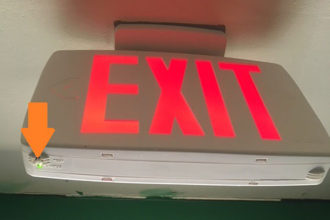
As you go up and down the aisles, just look for things that don’t look right. Look up at the emergency lights to make sure they look like they’re maintained. Try to get a look at the sprinkler heads and see if they’re blocked or impeded by storage or decorations. As you come across an extinguisher, check the inspection tag and make sure it’s in date. Does the gauge have good pressure?
Another thing to look for is whether the building powers everything with extension cords? Extension cords are very useful, but are designed for temporary use.
Nothing is better than an appropriately installed and well placed electrical outlet. If you see a ton of extension cords, that’s definitely a cause for concern.
As you’re looking around, how do your secondary and tertiary exits look? Again, are they well maintained? Are the paths leading to them free of clutter? Are they unlocked and ready for use? General clutter around a place is a sign that safety is perhaps a secondary concern of the owner or manager.
A quick drive around the building never hurts either. Are the doors you checked from the inside clear and reliable from the back? How does the storage situation look from back there? Are there combustible materials stacked right against the building?
So how else are you prepared for the worst? Does your EDC include a flashlight? (The one in your phone doesn’t count.) Imagine being in the back of the grocery store getting a pint of ice cream and the lights go out. For some reason, the emergency lights don’t work. Most grocery stores are lacking on windows, except at the front.
Can you find a way out through the dark, or even worse, through smoke? Maybe you just sent Jr. over to pick up his favorite cereal. Can you find him and get out in darkness and confusion? Carry a flashlight and make darkness one less thing you’ll have to worry about.
Be Assertive
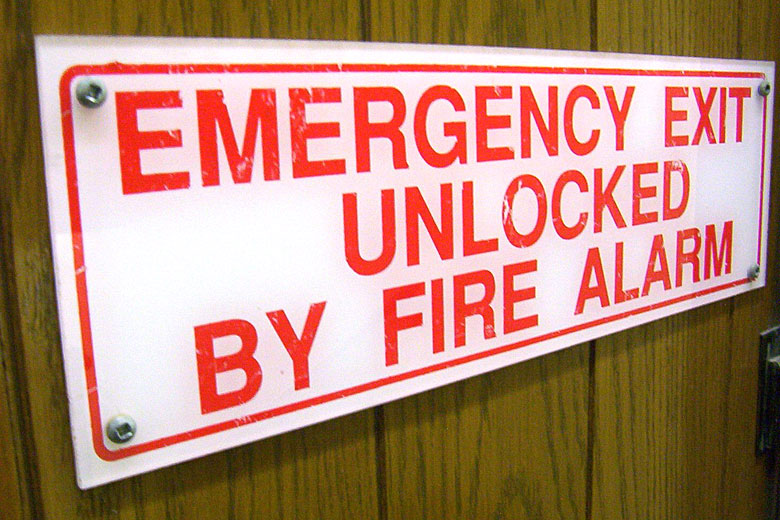
When the fecal matter hits the air circulation device, it’s time to be assertive. It’s time to use those exits that say employees only. It’s time to go through the entrance that says “No Exit.” (Hint: Those automatic doors that close behind you can be opened easily by pulling them apart.) Don’t let someone turn you around and send you back through the danger to get out. In an emergency, there is no such thing as a VIP only exit.
It’s also crucially important to not to get complacent when you hear a fire alarm in public. I know they can be a nuisance, but head for the door as soon as you hear them. If everyone waits to see signs of smoke or fire, there will be a mad dash for the door. Your best bet is to already be outside when things get ugly.
All of these tips truly boil down to situational awareness. Rely on yourself for your safety, not on others. A lot of these tips will also help in situations other than fire, such as criminal acts or terrorism. If you should find establishments that don’t take safety seriously, (chained doors, high fire loads, blocked exits) don’t hesitate to report them to the local authorities. You may help yourself or someone else from becoming a statistic.
Looking for a good fire extinguisher? Check out this one for home use and this one for vehicle usage.
Editor’s Note: Please join us in welcoming Steven H. as a contributor here on ITS! Steven is married with two boys and has been with the Virginia Beach Fire Department since 2003. He’s served on engine and ladder companies, as an instructor at the fire academy and most recently in the Fire Marshal’s office. Before that, he volunteered as a firefighter in his hometown of Leola, Pennsylvania.






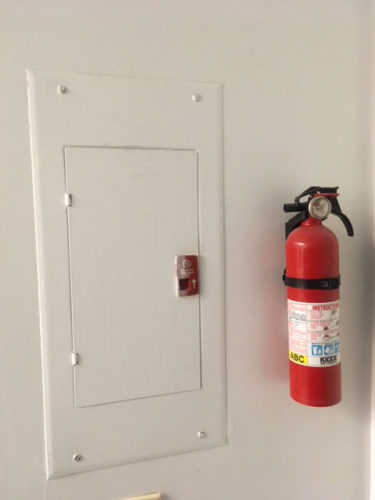

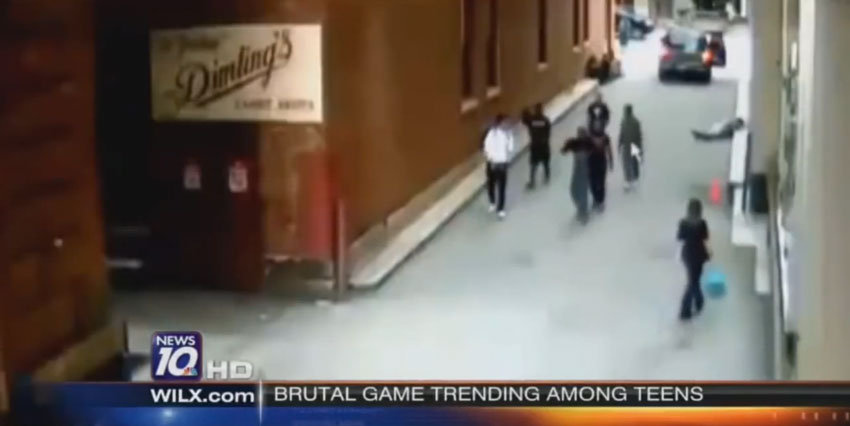
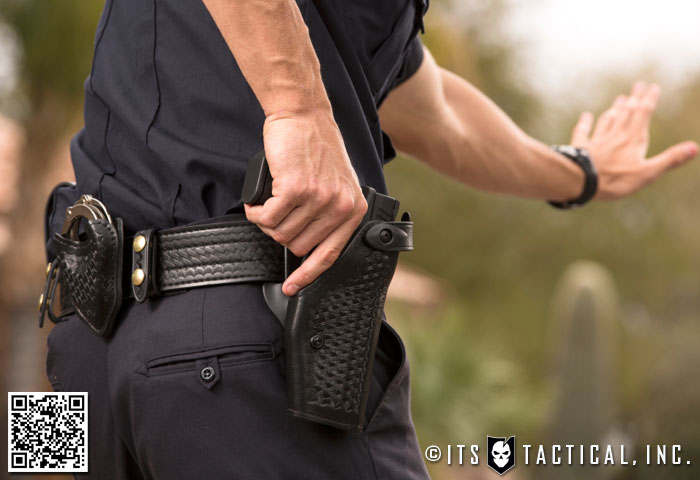
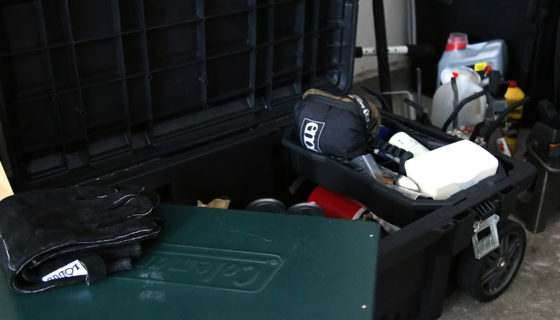

Discussion